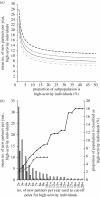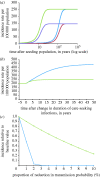A metapopulation modelling framework for gonorrhoea and other sexually transmitted infections in heterosexual populations
- PMID: 18986961
- PMCID: PMC2855508
- DOI: 10.1098/rsif.2008.0394
A metapopulation modelling framework for gonorrhoea and other sexually transmitted infections in heterosexual populations
Abstract
Gonorrhoea continues to be a public health problem in the UK, and is the second most common bacterial sexually transmitted infection (STI) after chlamydia. In the UK, gonorrhoea is disproportionately concentrated in epidemiologically distinct subpopulations, with much higher incidence rates in young people, some ethnic minorities and inner city subpopulations. The original model of STI transmission proposed by Hethcote and Yorke explained some of these features through the concept of the 'core group'. Since then, several authors have modified the original model approach to include multiple sexual activity classes, but found this modelling approach to be inadequate when applied to low-prevalence settings such as the UK. We present a metapopulation framework for modelling gonorrhoea and other STIs. The model proposes that the epidemiology of gonorrhoea is largely driven by subpopulations with higher than average concentrations of individuals with high sexual risk activity. We show how this conceptualization of gonococcal epidemiology overcomes key limitations associated with some of the prior efforts to model gonorrhoea. We also use the model to explain several epidemiological features of gonorrhoea, such as its asymmetric distribution across subpopulations, and the contextual risk experienced by members of at-risk subpopulations. Finally, we extend the model to explain the distribution of other STIs, using chlamydia as an example of a more ubiquitous bacterial STI.
Figures






Similar articles
-
Populations and partnerships: insights from metapopulation and pair models into the epidemiology of gonorrhoea and other sexually transmitted infections.Sex Transm Infect. 2010 Nov;86(6):433-9. doi: 10.1136/sti.2009.040238. Sex Transm Infect. 2010. PMID: 20940155
-
Epidemiology of incident chlamydia and gonorrhoea infections and population attributable fractions associated with living in the inner-core of Winnipeg, Canada.Int J STD AIDS. 2017 May;28(6):550-557. doi: 10.1177/0956462415614168. Epub 2016 Jul 10. Int J STD AIDS. 2017. PMID: 26503554
-
Epidemiology and clinical presentation of gonorrhoea in England and Wales: findings from the Gonococcal Resistance to Antimicrobials Surveillance Programme 2001-2006.Sex Transm Infect. 2009 Sep;85(5):317-21. doi: 10.1136/sti.2008.034843. Epub 2009 Apr 20. Sex Transm Infect. 2009. PMID: 19383598
-
Sexually transmitted infections among US women and men: prevalence and incidence estimates, 2008.Sex Transm Dis. 2013 Mar;40(3):187-93. doi: 10.1097/OLQ.0b013e318286bb53. Sex Transm Dis. 2013. PMID: 23403598 Review.
-
Issues in the management of sexually transmitted diseases in Papua New Guinea.P N G Med J. 1996 Sep;39(3):252-60. P N G Med J. 1996. PMID: 9795576 Review.
Cited by
-
Estimated Impact of Screening on Gonorrhea Epidemiology in the United States: Insights From a Mathematical Model.Sex Transm Dis. 2018 Nov;45(11):713-722. doi: 10.1097/OLQ.0000000000000876. Sex Transm Dis. 2018. PMID: 29894368 Free PMC article.
-
The potential impact of a vaccine on Neisseria gonorrhoeae prevalence among heterosexuals living in a high prevalence setting.Vaccine. 2023 Aug 31;41(38):5553-5561. doi: 10.1016/j.vaccine.2023.07.048. Epub 2023 Jul 28. Vaccine. 2023. PMID: 37517908 Free PMC article.
-
Antibiotic-Resistant Neisseria gonorrhoeae Spread Faster with More Treatment, Not More Sexual Partners.PLoS Pathog. 2016 May 19;12(5):e1005611. doi: 10.1371/journal.ppat.1005611. eCollection 2016 May. PLoS Pathog. 2016. PMID: 27196299 Free PMC article.
-
Cost-effectiveness of Chlamydia vaccination programs for young women.Emerg Infect Dis. 2015 Jun;21(6):960-8. doi: 10.3201/eid2106.141270. Emerg Infect Dis. 2015. PMID: 25989525 Free PMC article.
-
Double trouble: modelling the impact of low risk perception and high-risk sexual behaviour on chlamydia transmission.J R Soc Interface. 2018 Apr;15(141):20170847. doi: 10.1098/rsif.2017.0847. J R Soc Interface. 2018. PMID: 29618527 Free PMC article.
References
-
- Becker K. M., Glass G. E., Brathwaite W., Zenilman J. M. 1998. Geographic epidemiology of gonorrhea in Baltimore, Maryland, using a geographic information system. Am. J. Epidemiol. 147, 709–716. - PubMed
-
- Brunham R. C., Plummer F. A. 1990. A general model of sexually transmitted disease epidemiology and its implications for control. Med. Clin. North Am. 74, 1339–1352. - PubMed
MeSH terms
LinkOut - more resources
Full Text Sources
Medical

